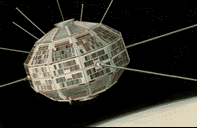|
|
Launched on September 29, 1962, the Alouette-I scientific
satellite marked Canada's entry into the space age and
was seen by many as initiating the most progressive
space program of that era.
With the Alouette launch, Canada became the first nation, after the
Russian and American superpowers, to design and build its own
artificial Earth satellite.
|

|
The
development of Alouette-I came as a result of an American
invitation, through the newly formed National Aeronautics and
Space Administration (NASA) in 1958, for international
collaboration in its budding satellite program. Within months,
John Chapman and Eldin Warren, scientists at Canada's Defence
and Research Telecommunications Establishment (DRTE),
submitted to NASA a proposal to design and build a Canadian
satellite that could monitor the ionosphere from above. The
proposal was accepted and a team of DRTE scientists was formed
under Chapman's leadership to began the process of designing
and building two identical Alouette models.
With
no experience in building satellites, the progress of the DRTE
team was slow and riddled with engineering problems. However,
new technologies, such as transistors and solar cells became
available during this period and helped make it possible to
build a small, reliable spacecraft.
Contractors
such as RCA and Spar Aerospace Limited produced their first
space hardware products during Alouette's construction. Spar,
for instance, developed a new "roll-up" antenna for
the Canadian satellite, a product that was later used in many
variations for American satellites.
After
three and a half years of design and construction, the 145-kg
satellite was flown to California and launched from the
Pacific Missile Range at 2:06 a.m. EST on Saturday, September
29, 1962. Sprung from a two-stage Thor-Agena rocket, Alouette-I
was quickly put into a near perfect 1000 km orbit and soon
began its top-down study of the ionosphere.
Alouette-I
was a tremendous success by any measure. The conservative
research approach adopted by the DRTE team paid off manyfold
as the satellite eventually stretched its one-year design life
into an unprecedented 10-year mission, producing over one
million images of the ionosphere in the process.
Following
the success of Alouette-I, Canada and United States signed an
agreement to launch further satellites under a new program
called International Satellites for Ionospheric Studies
(ISIS). Under the program, the Alouette back-up model was
refurbished and flown in 1965 as "Alouette-II" and
two new satellites, named ISIS I and ISIS II, were
successfully launched in 1969 and 1970 respectively.
|